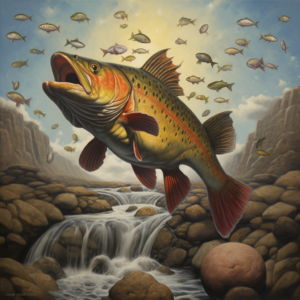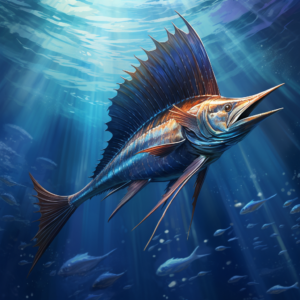Unveiling the Secrets of the Deep Sea
Prepare to be enthralled by the secrets of the deep sea. Underwater exploration has never been more exciting as you step into the abyssal zone and discover a world filled with wonder and mystery. Oceanography, the science of studying the ocean, has revealed many incredible insights into the unique environment of the deep sea.
Did you know that the deep sea begins at around 200 meters below the surface? This region is also called the twilight zone due to the limited amount of sunlight that penetrates it, making it difficult for photosynthesis to occur. As you descend further, you will enter the abyssal zone, where an incredible array of deep-sea creatures reside.
“The deep sea is the largest habitat on our planet, covering over 70% of the Earth’s surface. Even with all of our advancements in technology, we have only explored less than 5% of it. The possibilities for discovery and exploration are endless!”
As you explore the deep sea, you will encounter some of the most fascinating creatures that inhabit our planet. From bioluminescent deep-sea jellyfish to colossal squids, life in the deep sea has evolved in extraordinary ways to adapt to the extreme environment.
Deep-sea diving is an excellent way to explore this fascinating world. With the proper training, equipment, and safety measures, you can safely immerse yourself in the depths of the ocean and witness firsthand the marvels of the deep sea.
Equipping Yourself for Deep-Sea Fishing Success
Rods and Reels:
Lines and Leaders:
Baits and Lures:
Other Equipment:
Other essential gear includes a fishing knife, pliers, and a gaff hook to assist with landing large fish. A good pair of polarized sunglasses will help reduce glare and improve visibility. Don’t forget to bring a cooler to store your catch and plenty of water and snacks to stay hydrated and energized.
It’s crucial to choose the right equipment based on the marine life you’re likely to encounter on your deep-sea fishing trip. Be prepared to adjust your gear as needed and always make sure it is in good condition before heading out to sea. With the right equipment, you’ll be well on your way to a successful deep-sea fishing adventure. Happy fishing!
Techniques and Strategies for Deep-Sea Fishing
Bait and Lure Selection
Bottom Fishing and Trolling
Reading Underwater Currents
Identifying Areas with High Fish Activity
Many deep-sea fish are attracted to specific underwater structures, such as reefs or shipwrecks. Use a fish finder or research the area before your trip to identify potential hotspots for the species you’re targeting. Keep an eye out for signs of fish activity, such as jumping or feeding, to clue you in on where to drop your line.
Pro Tip: Bring a variety of equipment, such as different types of bait and lures, to adapt to changing conditions and increase your chances of a successful catch.
By incorporating these techniques and strategies, you can increase your chances of catching the deep-sea creatures you desire. Remember to be patient and keep trying, as deep-sea fishing can sometimes require multiple trips before successfully landing the big one.
Unforgettable Encounters with Deep-Sea Creatures
Get ready for an unforgettable experience as you dive into the mesmerizing world of deep-sea creatures. You’ll encounter an incredible variety of marine life that inhabits the depths, from the majestic whales to the mysterious giant squid.
As you explore the underwater environment, you’ll notice that these creatures have incredible adaptations that allow them to survive in this unique habitat. Some have bioluminescent features that light up the dark depths, while others have sharp teeth and powerful jaws that help them catch their prey.
“One of the most unforgettable creatures you may encounter during your deep-sea fishing adventure is the magnificent shark. With their sleek bodies and razor-sharp teeth, these predators are sure to leave a lasting impression.”
But it’s not just about the big predators. You’ll also encounter vibrant schools of fish, colorful coral reefs, and strange-looking creatures that seem to come straight out of a science fiction movie. Take the time to observe these amazing creatures and learn about their unique characteristics and behaviors.
Of course, it’s important to interact with deep-sea creatures responsibly. Always follow best practices for observing and interacting with the marine life, and avoid touching or disturbing them whenever possible. With proper education and awareness, you’ll be able to enjoy these amazing experiences without harming the environment or its inhabitants.
Safety Measures and Emergency Preparedness in the Deep Sea
Essential Safety Measures
First and foremost, always wear a life jacket when on the boat. It’s also wise to bring a whistle, flashlight, and other signaling devices in case of an emergency. Never go deep-sea fishing alone, and always inform someone of your itinerary before departing.
Familiarize yourself with the boat’s layout and the location of life jackets and emergency equipment. Make sure you know how to operate the radio and are aware of any emergency protocols established by the captain or crew.
Risk Assessment
Understanding common risks associated with deep-sea fishing is critical to staying safe. Be aware of the weather and ocean conditions, and avoid fishing during storms or rough seas. Pay attention to any changes in the weather or sea conditions during your trip, and be prepared to return to shore if necessary.
Deep-sea fishing can also expose you to potential health risks, such as sunburn, seasickness, and dehydration. Protect yourself by wearing sunscreen, bringing plenty of water, and taking breaks from the sun as needed.
Emergency Preparedness
In case of an emergency, it’s crucial to be prepared. Make sure you have a first aid kit on board, and know how to administer basic first aid for common injuries. Familiarize yourself with emergency procedures, such as how to use the boat’s emergency radio or how to signal for help.
If someone falls overboard, immediately throw a floatation device into the water and alert the crew. Always keep a close eye on your fellow passengers and notify the captain if anyone appears ill or injured.
Following these safety measures and emergency preparedness tips will help ensure a safe and enjoyable deep-sea fishing experience. Always prioritize safety and be prepared for any situation that may arise during your underwater exploration.
Conclusion
FAQ
Q: What is deep-sea fishing?
A: Deep-sea fishing refers to fishing in the deeper waters of the ocean, typically beyond the continental shelf. It involves targeting fish species that inhabit these deeper areas, such as tuna, marlin, and swordfish.
Q: What equipment do I need for deep-sea fishing?
A: You will need a few essential pieces of equipment for deep-sea fishing, including a sturdy fishing rod and reel, strong fishing line, a variety of fishing lures and bait, as well as a tackle box to store your gear.
Q: How do I choose the right equipment for deep-sea fishing?
A: The choice of equipment depends on various factors, such as the type of fish you are targeting, the depth at which you will be fishing, and the current and weather conditions. It’s important to select gear that is suitable for the specific conditions and the size and strength of the fish you aim to catch.
Q: What fishing techniques can I use for deep-sea fishing?
A: There are several fishing techniques that are commonly used in deep-sea fishing, including trolling, bottom fishing, and deep-drop fishing. Each technique has its advantages and is suitable for different circumstances and target species.
Q: Are there any safety measures I should take while deep-sea fishing?
A: Yes, safety should always be a top priority when engaging in deep-sea fishing. It is important to wear appropriate safety gear, such as a life jacket, and ensure that you have proper knowledge of emergency procedures and first aid. It’s also recommended to go deep-sea fishing with experienced individuals or a reputable charter service.
Q: Can I encounter deep-sea creatures while deep-sea fishing?
A: Absolutely! Deep-sea fishing provides a unique opportunity to encounter a variety of fascinating deep-sea creatures, including sharks, dolphins, and various types of fish. However, it’s important to respect and observe these creatures from a safe distance to avoid disrupting their natural habitat.
Q: Is deep-sea fishing suitable for beginners?
A: While deep-sea fishing can be an exciting and rewarding activity, it does require some level of experience and knowledge. It’s recommended for beginners to start with smaller fishing trips and gradually work their way up to more advanced deep-sea fishing excursions, preferably under the guidance of an experienced angler or charter service.




